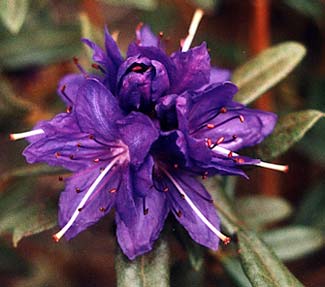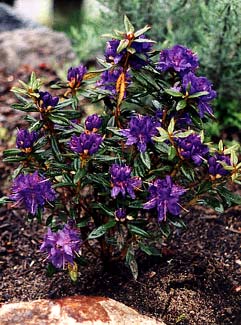 Rhododendron 'Starry Night'
Rhododendron 'Starry Night'
"Starry, starry night
Paint your palette blue & gray
Look out on a summer's day
With eyes that know the darkness in my soul"
-Don McLean,
b. 1945
b. 1945
Generally speaking I obtain rhododendron bushes old enough to already have a substantial look in our gardens, as they are usually slow-growers, & to have mature rhodies it is necessary to make the investment in the size desired. But some dwarf hybrids can be stunning bloomers even in their "infancy" & behave like mature shrubs when less than a foot tall.
 'Starry Night' is one such shrub, & I figured, oh, what the heck, that's so pretty, I'll put in a tiny one so that I have at least one infant to watch develop. It is listed as growing three to four feet high & wide in ten years, so this twelve-incher was young indeed, though already with pleasing shape, & blossoms small enough they don't look absurdly large on too small a shrub. I figured it would be as slow growing as most rhodies, but in three years it had already sprang up to three feet, much faster than the purported average, so my patience was not tested.
'Starry Night' is one such shrub, & I figured, oh, what the heck, that's so pretty, I'll put in a tiny one so that I have at least one infant to watch develop. It is listed as growing three to four feet high & wide in ten years, so this twelve-incher was young indeed, though already with pleasing shape, & blossoms small enough they don't look absurdly large on too small a shrub. I figured it would be as slow growing as most rhodies, but in three years it had already sprang up to three feet, much faster than the purported average, so my patience was not tested.This Hachmann hybrid is a true sun-lover despite it's night-time shade of deepest bluest purple. In the mid-April photo of the bloom, you can see why it might be referred to as Starry, having even rays of light poking out of it.
Developed by Germany's leading rhododendron hybridizing family, their name for it is actually 'Gletschernacht,' though it is sold stateside with its name translated 'Starry Night,' occasionally as 'Glacier Night.' Johannes Hachmann founded the Hachmann nursery in 1929. His son Hans took it over in 1952. Since 1989 it has been operated by his grandson Holger Hachmann. Their extensive exhibition garden in Barmstedt welcomes visitors; it is best visited in May or June to see the greatest number of rhododendrons in full glory.
The species that provides the main thread of this hybrid's heritage, R. russatum, is a "lepidote" or scaly-leafed rhododendron, with notable winter redness on the underside of evergreen leaves. It was first described by famed plant explorer George Forrest in 1917, when on one of his Yunnan China quests he spotted it along the Kari Pass at 9,000 feet. You can read a little bit more about Forrest's plant-hunting exploits on the Rhododendron yungningense page.
The wild shrub in its native setting has many distinct forms across its extensive range, some extremely dwarfed & never reaching a foot in height, the biggest reaching five feet. A deep purple form exhibited by rhododendron fanatic Lionel de Rothschild in 1933 received a First Class Certificate, & it is likely 'Starry Night' is descended from it.
Though cold-hardy to minus 15 Fahrenheit, it is far less forgiving of heat, so will not thrive in as many zones as hardier rhodies. We're lucky that Puget Sound weather is ideal for almost any rhododendron we want. We gave ours a morning-sunny location where it has grown a little faster than expected yet remained fairly compactly leafed.